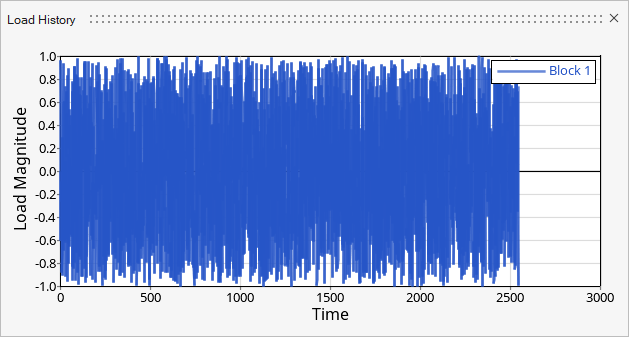HL-T: 1040 Factor of Safety (FOS)
In this tutorial you will:
- Import a model to HyperLife
- Select the FOS module and define its required parameters
- Create and assign materials
- Assign load histories for scaling the stresses from FEA subcases
- Evaluate and view results
Before you begin, copy the file(s) used in this tutorial to your
working directory.
Import the Model
-
From the Home tools, Files tool group, click the Open Model tool.
Figure 1. 
-
From the Load model and result dialog, browse and select
HL-1040\Springlink_FOS.h3d for the model
file.
The Load Result field is automatically populated. For this tutorial, the same file is used for both the model and the result.
-
Click Apply.
Figure 2. 
Tip: Quickly import the model by dragging and
dropping the .h3d file from
a windows browser into the HyperLife
modeling window.
Define the Fatigue Module
-
Click the arrow next to the fatigue module icon and select the
FOS tool from the list of options.
Figure 3. 
The FOS dialog opens. -
Accept the default parameters.
Figure 4. 
- Exit the dialog.
Assign Materials
-
Click the Material tool.
Figure 5. 
The Assign Material dialog opens. - Activate the checkbox for the part spring_link_fine.
-
Edit the FOS material.
- Click the My Material tab.
- Enter a value of 1000 for TFL.
- Enter a value of 0.5 for HSS.
- Enter a value of 0.0 for Shear Threshold.
- Enter a value of 0.0 for Safe Zone Angle.
- Click Plot and Save.
Figure 6. 
- Click the Assign Material Data tab.
-
Verify the following properties.
Figure 7. 
- Exit the dialog.
Assign Load Histories
-
Click the Load Map tool.
Figure 8. 
The Load Map dialog opens. - From the Channel Type drop-down menu at the top of the dialog, select Time Data.
-
Click
 in the Choose File
field and browse for load1.csv.
in the Choose File
field and browse for load1.csv.
-
Click
 to add the load case.
to add the load case.
- Optional:
Click
 to view a plot of the load.
to view a plot of the load.
Figure 9. Load 1 
Tip: Expand the width of the dialog to view a clearer picture of the plot. -
On the bottom half of the dialog, set the radio button to
Manual for event creation and click
 three times to create three event headers.
three times to create three event headers.
- Drag and drop Subcase 1 under Event_1, Subcase 2 under Event_2, and Subcase 3 under Event_3.
- Drag and drop the Block file under load1 onto the Channels field of all three subcases.
- Activate the checkboxes for the three events.
- Set LDM to 1.0, Scale to 3.0 and Offset to 0.0 for Subcase 1.
-
Right-click on the Scale field of Subcase 1 and select Apply value
to all events.
Figure 10. 
- Exit the dialog.
Evaluate and View Results
-
From the Evaluate tool group, click the
Run Analysis tool.
Figure 11. 
The Evaluate dialog opens.Figure 12. 
- Optional: Enter a name for the run.
-
Click Run.
Result files are saved to the home directory and the Run Status dialog opens.
- Once the run is complete, click View Current Results.
-
Use the Results Explorer to
visualize various types of results.
Figure 13. 